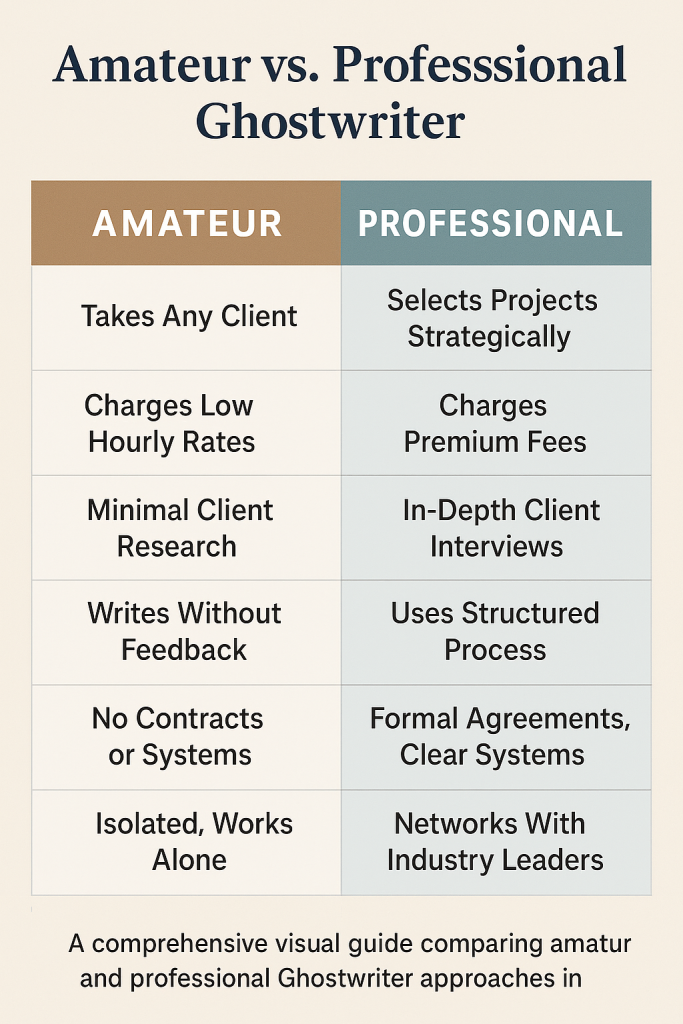The $50,000 Ghostwriting Gap That Separates Winners from Strugglers
North American ghostwriting presents a stark earning divide—top professionals command $150+ per hour, while others struggle at poverty wages. 1 This disparity isn’t about talent — it’s about avoiding six critical business mistakes that separate amateur writers from six-figure ghostwriting practices.
Recent data from the Bureau of Labor Statistics show median writer earnings of $69,510 annually, but elite ghostwriters earn $ 150,000 or more by mastering business fundamentals that most writers overlook.
The North American market presents unprecedented opportunities for skilled writers who recognize that craft alone is insufficient — strategic business positioning drives premium pricing and sustainable growth.
 This breakdown reveals the exact mistakes keeping talented writers stuck in low-paying gigs—and the systematic approach top ghostwriters use to build profitable, scalable businesses.
This breakdown reveals the exact mistakes keeping talented writers stuck in low-paying gigs—and the systematic approach top ghostwriters use to build profitable, scalable businesses.
Mistake #1: Catastrophic Pricing Errors That Cost You Thousands
The $15/Hour Poverty Trap
Most new ghostwriters price themselves into poverty. They calculate hourly rates based on a minimum wage mindset, rather than delivering professional value. This creates a devastating cycle: low rates attract problem clients who demand endless revisions, creating more work for less money.
Professional ghostwriters understand pricing psychology. When you charge 25/hour, clients question your expertise. When you charge $125 per hour, they assume you’re worth it.
The Freelancers Union reports that writers charging premium rates have 40% higher client retention rates and significantly better project outcomes.
Premium Rate Psychology and Market Positioning
Premium pricing acts as a quality filter. High-paying clients respect your time, follow your processes, and value your expertise. They understand that professional ghostwriting requires research, strategy, and skill, not just typing ability.
Calculate your rates using the Professional Ghostwriter Formula:
-
- Base hourly rate: $75-150 (based on experience and specialization)
- Project complexity multiplier: 1.2- 2.0x
- Rush job premium: 1.5- 2.0x additional
- Revision rounds: Limited to 2-3 with clear scope
Value-Based Pricing Framework Implementation
Transform your pricing from a time-based to a value-based approach. Instead of charging for hours, charge for outcomes. A ghostwritten book that generates 100,000 speaking fees for your client is worth 15,000- 25,000, not $3,000.
Value-based pricing elements include:
-
- Client’s potential ROI from the project
- Your unique expertise and market position
- Project complexity and research requirements
- Timeline and availability constraints
- Long-term relationship potential
Mistake #2: Boundary Failures That Destroy Professional Relationships
Scope Creep Prevention Systems
Professional ghostwriters establish clear boundaries from the first client interaction. They define the project scope, revision limits, and communication protocols in writing before any work begins.
Implement these boundary protection strategies:
-
- Detailed project contracts with specific deliverables
- Revision limits (typically 2-3 rounds)
- Communication schedules and preferred channels
- Additional work authorization processes
- Clear payment terms and schedules
Communication Protocol Establishment
Establish professional communication standards that position you as a business partner, not a service provider. This includes:
-
- Scheduled check-ins and progress updates
- Professional email templates and response times
- Project management system usage
- Meeting agendas and documentation
- Conflict resolution procedures
Contract Essentials and Legal Protection
The Authors Guild offers comprehensive contract templates that safeguard the interests of both writers and clients. Professional contracts must include:
-
- Detailed scope of work and deliverables
- Payment terms and schedule
- Intellectual property rights and attribution
- Confidentiality and non-disclosure agreements
- Termination clauses and dispute resolution

Mistake #3: Voice Consistency Failures That Expose Amateur Status
Voice Capture Techniques and Style Guides
Professional ghostwriters master voice capture—the ability to write authentically in their clients’ voices. This requires a systematic analysis of speech patterns, vocabulary preferences, and communication style.
Voice capture process includes:
-
- Initial voice analysis interviews (2-3 hours)
- Sample writing review and style documentation
- Ongoing voice consistency checks
- Client feedback integration systems
- Style guide development and maintenance
Quality Assurance Implementation
Implement multi-layer quality assurance systems that ensure every piece maintains voice consistency:
-
- Initial draft review for voice alignment
- Content accuracy and fact-checking
- Grammar and style consistency verification
- Client review and feedback integration
- Final proofing and polishing
Client Voice Maintenance Systems
Maintain detailed client voice profiles that include:
-
- Preferred vocabulary and phrases
- Sentence structure patterns
- Tone and personality characteristics
- Industry-specific terminology
- Communication preferences and style
Mistake #4: Business Structure Neglect That Limits Growth Potential
Legal Entity Setup and Tax Optimization
Professional ghostwriters operate as legitimate businesses, not hobbyists. The U.S. Small Business Administration offers guidance on selecting a business structure for freelance writers.
Consider these business structures:
-
- LLC for liability protection and tax flexibility
- S-Corporation for tax advantages at higher income levels
- Professional Corporation for specialized services
- Partnership structures for collaborative practices
Professional Systems and Workflow Management
Implement business systems that support growth and efficiency:
-
- Client relationship management (CRM) systems
- Project management and tracking tools
- Financial management and invoicing systems
- Content creation and collaboration platforms
- Backup and security protocols
Scalability Planning and Revenue Diversification
Build your ghostwriting business for scale, not just survival. This includes:
-
- Passive income stream development
- Subcontractor and team building capabilities
- Premium service tier creation
- Long-term client relationship cultivation
- Intellectual property and course development
Mistake #5: AI Integration Missteps That Compromise Quality
Strategic AI Tool Selection
Professional ghostwriters utilize AI as a research and efficiency tool, not a replacement for human creativity and insight. Select AI tools that enhance your capabilities without compromising authenticity.
Recommended AI integration approaches:
-
- Research and fact-checking assistance
- Outline and structure development
- Grammar and style consistency checking
- Content optimization and SEO enhancement
- Administrative task automation
Human-AI Collaboration Best Practices
Maintain the human element that clients value while using AI for efficiency gains:
-
- Use AI for initial research and data gathering
- Apply human insight for strategy and voice development
- Maintain personal client relationships and communication
- Ensure final content reflects authentic human experience
- Continuously update skills to stay ahead of AI capabilities
Quality Control and Authenticity Maintenance
Establish quality control processes that ensure AI-assisted content maintains authenticity:
-
- Human review of all AI-generated content
- Voice consistency verification systems
- Fact-checking and accuracy validation
- Plagiarism and originality verification
- Client satisfaction and feedback integration
Mistake #6: Client Acquisition Failures That Keep You Struggling
Target Market Identification and Positioning
Professional ghostwriters serve specific markets with specialized expertise, not general audiences with generic services . Identify your ideal client profile and develop targeted marketing strategies.
High-value ghostwriting niches include:
-
- Executive thought leadership and business books
- Professional memoir and autobiography writing
- Industry-specific content and white papers
- Political and advocacy writing
- Celebrity and high-profile client services
Portfolio Development and Case Study Creation
Build a portfolio that demonstrates results, not just writing samples:
-
- Before/after case studies showing client outcomes
- Testimonials with specific results and metrics
- Industry recognition and awards documentation
- Media coverage and professional achievements
- Specialized expertise and certification proof
Referral Systems and Networking Strategies
Develop systematic referral generation and professional networking:
-
- Client referral programs with incentives
- Professional association membership and participation
- Industry conference speaking and attendance
- Content marketing and thought leadership
- Strategic partnership development
The International Association of Business Communicators provides networking opportunities and professional development resources for ghostwriters serving corporate clients.
Success Stories – Ghostwriters Who Cracked the Code

Sarah Mitchell, Executive Ghostwriter
“After implementing professional pricing and boundary systems, I doubled my rates from 50to100 per hour within three months. My clients now respect my expertise and follow my processes without question.”
Sarah’s transformation included:
-
- Business structure conversion to LLC
- Premium service positioning
- Systematic client onboarding process
- Value-based pricing implementation
Marcus Rodriguez, Business Book Ghostwriter
“The contract templates and scope management systems eliminated my scope creep problems. I now complete projects on time and on budget while maintaining excellent client relationships.”
Marcus achieved success through:
-
- Professional contract implementation
- Clear communication protocols
- Project management system adoption
- Boundary enforcement strategies
Jennifer Chen, Memoir Ghostwriter
“Learning to balance AI tools with human insight transformed my efficiency without compromising quality. I can now take on 50% more clients while delivering better results.”
Jennifer’s approach included:
-
- Strategic AI tool integration
- Quality control system development
- Efficiency optimization
- Capacity expansion planning
Your Professional Transformation Action Plan
Immediate Actions (Week 1-2)
-
- Audit current pricing and adjust to market standards
- Implement professional contracts and boundary systems
- Establish a business entity and financial management
- Develop client communication protocols
Short-term Development (Month 1-3)
-
- Create voice capture and style guide systems
- Build a comprehensive portfolio and case studies
- Implement AI tools for efficiency enhancement
- Develop referral and networking strategies
Long-term Growth (Month 3-12)
-
- Scale business operations and team development
- Diversify revenue streams and passive income
- Establish thought leadership and industry recognition
- Build premium service offerings and specializations
Success Metrics and Milestone Tracking
-
- Hourly rate increases (target: 2- 3x within 6 months)
- Client retention rates (target: 85 %+ repeat business)
- Project completion efficiency (target: on-time, on-budget)
- Revenue growth (target: 50-100% annual increase)
- Professional recognition and referral generation
Frequently Asked Questions About Professional Ghostwriting
How much should I charge as a North American ghostwriter?
Professional ghostwriters in North America charge $ 75- $ 150+ per hour, based on experience, specialization, and client type. Project-based pricing ranges from $ 5,000 to $ 50,000+, depending on the scope and complexity.
What’s the biggest mistake new ghostwriters make?
The biggest mistake is underpricing services and failing to establish professional boundaries. This attracts problem clients and fosters unsustainable business practices.
Should I use AI tools in my ghostwriting practice?
Yes, but strategically. Utilize AI for research, efficiency, and quality control while preserving human insight, creativity, and authentic voice development.
How do I find high-quality ghostwriting clients?
Focus on specific market niches, develop professional portfolios with case studies, implement referral systems, and network within professional associations.
What business structure should I use for ghostwriting?
Most professional ghostwriters benefit from an LLC structure for liability protection and tax flexibility. Consult with business attorneys and accountants for personalized guidance.
How do I maintain client voice consistency?
Develop detailed voice profiles, implement multi-layered quality assurance systems, and maintain ongoing client communication and feedback integration.


